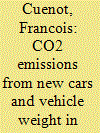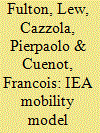|
|
|
Sort Order |
|
|
|
Items / Page
|
|
|
|
|
|
|
| Srl | Item |
| 1 |
ID:
091529


|
|
|
|
|
| Publication |
2009.
|
| Summary/Abstract |
A segment- and fuel-disaggregated analysis of the production data of the new European vehicle market during the last decade helps to understand the sharp increase in average weight, and to introduce an indicator linking CO2 emissions to a vehicle's unit of weight. Using this indicator, simulations are made to calculate the average CO2 emissions if the average weight had stayed constant from 1995 to 2005. If the weight had remained constant, the 2008 target of 1998s voluntary agreement (VA) would have been met, and the recently approved regulation would probably have been unnecessary. Then, CO2 emissions are projected to 2015 using different vehicle characteristics and market penetration. Five scenarios have been introduced to study the different opportunities that could arise by 2015, including a backcasting scenario showing what is needed to reach the goal set by the recently approved EU climate package regulations. The analysis concludes that powertrain technologies alone are unlikely to bring the sufficient break in trends to reach set targets. Acting on average weight, through unitary vehicle weight or segment shifting, of new vehicles is key in reducing the average CO2 emissions in the short and medium term.
|
|
|
|
|
|
|
|
|
|
|
|
|
|
|
|
| 2 |
ID:
091517


|
|
|
|
|
| Publication |
2009.
|
| Summary/Abstract |
The IEA published "Energy Technology Perspectives" (ETP) in June 2008. That document reports on IEA scenarios for baseline and low-CO2 alternative scenarios to 2050, across the energy economy. The study included creating scenarios for transport, using the IEA Mobility Model (MoMo). This paper reports on the transport-related ETP scenarios and describes the model used in the analysis. According to the ETP Baseline scenario, world transport energy use and CO2 emissions will more than double by 2050. In the most challenging scenario, called "BLUE", transport emissions are reduced by 70% in 2050 compared to their baseline level in that year (and about 25% below their 2005 levels). There are several versions of the BLUE scenario, but all involve: a 50% or greater improvement in LDV efficiency, 30-50% improvement in efficiency of other modes (e.g. trucks, ships and aircraft), 25% substitution of liquid fossil fuels by biofuels, and considerable penetration of electric and/or fuel-cell vehicles. In the second half of this paper, an overview of the MoMo model is provided. Details on the complete analysis are contained in the ETP 2008 document, available at www.iea.org. Details of the LDV fuel economy analysis are contained in a separate paper in this collection.
|
|
|
|
|
|
|
|
|
|
|
|
|
|
|
|
| 3 |
ID:
111319


|
|
|
|
|
| Publication |
2012.
|
| Summary/Abstract |
Travel statistics for most countries are subject to numerous uncertainties. But as presented in this paper, the IEA has developed a sufficient database to estimate passenger travel by mode for major countries and regions around the world, and produce consistent travel and energy use estimates, perhaps the first of their kind. For example, we estimate that in 2005 total global passenger travel using motorised modes was about 40 trillion kilometres, or about 6000 per person. The IEA has also developed a set of travel projections to 2050, including a Baseline and a "Modal Shift" scenario. This paper provides the result of this analysis and estimates the potential impacts on CO2 from a 25% reduction in car and air travel by 2050 relative to the Baseline in that year. The modelling effort and policy analysis used to support the findings are also described.
|
|
|
|
|
|
|
|
|
|
|
|
|
|
|
|
|
|
|
|
|